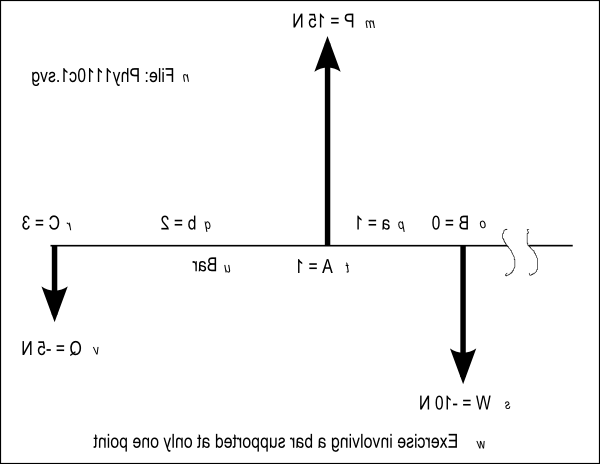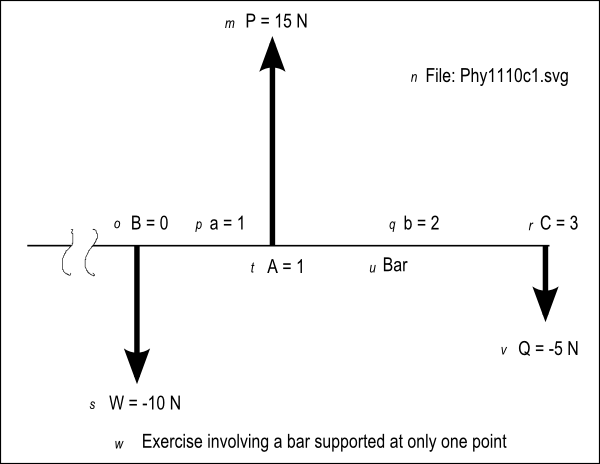| << Chapter < Page | Chapter >> Page > |
In the absence of the forces P and Q, the force R would produce the same turning effect on the bar as do the forces P and Q jointly.
If the magnitude of R were not equal to the magnitude of W, the vector sum of the forces would not be zero, there would be a torque about any point on the barother than at the point C, and the bar would not be in equilibrium.
Tactile graphics
The file named Phy1110c1.svg contains a vector diagram that represents this scenario. All of the action occurs near the right end of the bar, so only theright end is shown in the image.
Figure 8 shows the mirror image that is contained in that file for the benefit of your assistant who will create the tactile graphicfor this exercise.
| Figure 8 . Mirror image from the file named Phy1110c1.svg. |
|---|
 |
Figure 9 shows a non-mirror-image version of the same image.
| Figure 9 . Non-mirror-image version of the image from the file named Phy1110c1.svg. |
|---|
 |
Figure 10 shows the key-value pairs that go with the image in the file named Phy1110c1.svg.
| Figure 10 . Key-value pairs for the image in the file named Phy1110c1.svg. |
|---|
m: P = 15 N
n: File: Phy1110c1.svgo: B = 0
p: a = 1q: b = 2
r: C = 3s: W = -10 N
t: A = 1u: Bar
v: Q = -5 Nw: Exercise involving a bar supported at only one point |
Unlike or antiparallel
It's time to modify your drawing to reflect a different scenario.
Make your bar 20 units in length. Draw a downward force labeled Q at the right end of the bar. Label this as point C on the bar.
Draw an upward force labeled P somewhere on the bar. Label the location of this point on the bar as A
In this case, we have two parallel forces, P and Q pulling in opposite directions but not in the same line of action. These forces are said to be unlike or antiparallel .
Add another downward force
Draw a downward force labeled W somewhere to the left of A. Label this point as B and consider it to be the horizontal origin. Directions to the right of Bare positive directions.
Label the horizontal distance from B to A as a. Label the horizontal distance from A to C as b.
What is required for equilibrium?
We can look at this scenario and tell that the forces labeled W and P, both of which point down, must be on opposite sides of the force labeled P.Otherwise, the bar will rotate in a clockwise direction.
The following two conditions must be true for the bar to be in equilibrium.
P + W + Q = 0, or
P = - (W + Q) (vector sum must be zero)
a*P + (a+b) * Q = 0 (moments around point B)
The plan
We will set values for all the variables in the twoconditions other than a and P and then solve for values of a and P that will result in the bar being in equilibrium .
The computations
Substituting these values into the two conditions and rearranging terms gives us:
P = -(W + Q), or
P = 15 , this is one of the answers
a*P +(a+2)*(-5) = 0, or
15*a -5*a -10 = 0, or
10*a = 10, or
a = 1 , this is the other answer
The answers
Therefore, for the values of W, Q, and b given above , P must be equal to 15 and a must be equal to 1 for the bar to be in equilibrium.

Notification Switch
Would you like to follow the 'Accessible physics concepts for blind students' conversation and receive update notifications?